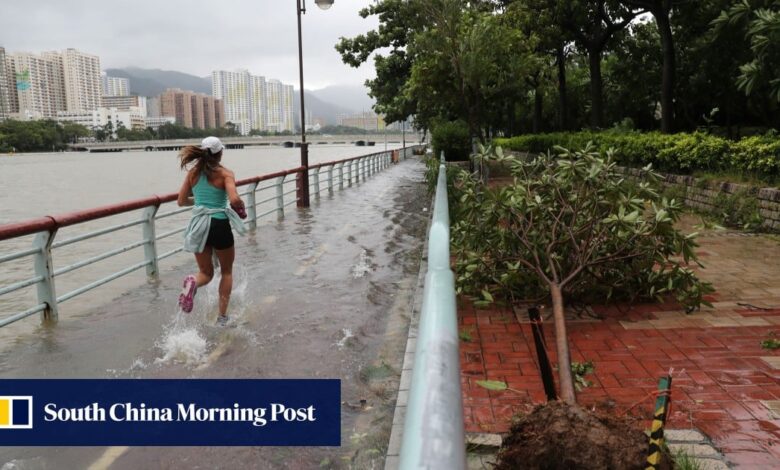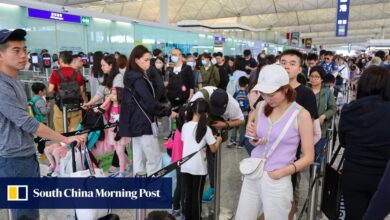Typhoon Saola aftermath: Hong Kong wakes to debris and fallen trees on roads, but damage not as bad as feared

[ad_1]
The No 8 signal will remain in force until at least 4pm on Saturday, according to the Observatory.
As Saola weakened and moved away from the city in the morning, its trail of destruction also came to light.
480 Hong Kong flights to resume as effects of Typhoon Saola wane
480 Hong Kong flights to resume as effects of Typhoon Saola wane
At least 63 people received hospital treatment in Hong Kong during the storm, according to reports as of 9am. Some 505 people sought refuge across 40 temporary storm shelters set up citywide.
Authorities received 123 reports of fallen trees as of 9am. Roads across the city were scattered with numerous tree parts that briefly disrupted traffic on thoroughfares such as the Island Eastern Corridor and Gloucester Road in Wan Chai.

Service on the MTR’s east rail line was briefly suspended on Saturday morning between the Fanling and University stations for debris to be cleared off the tracks.
A metal fence was found splayed across all six lanes of Chatham Road South in Tsim Sha Tsui on Friday night. In Ho Man Tin, a 20-metre-long metal fence outside police’s Kowloon West regional headquarters collapsed onto the pavement along Tin Kwong Road.
Solar panels were blown off rooftops of high-rise residential buildings at multiple locations, including in Tsuen Wan and Cheung Sha Wan in Kowloon.

Many residents of Lohas Park developments in Tseung Kwan O reported on social media constant swaying of their high-rise blocks. Some users said they suffered headaches and motion sickness, with a resident named Billy Kwan saying he had to “take a break” at the shopping centre downstairs.
Multiple Facebook users living in the same area also posted pictures of broken windows or cracked glass at home.

In response, the Buildings Department said on social media the phenomena was expected under a wind-effect code stipulated in design rules. A 100-metre-tall building, for instance, could sway up to 20cm horizontally, the maximum deviation allowed under the code.
Elsewhere, a malfunctioning overhead power line caused blackouts for about 20 minutes in 10 households in the rural area of Tso Kung Tam near Tsuen Wan, according to CLP Power.
Snakes alive! Hong Kong hospital staff find 30cm reptile near operating theatre
Snakes alive! Hong Kong hospital staff find 30cm reptile near operating theatre
Weather stations across Hong Kong recorded mean wind speed in excess of 100km/h on Friday, including at Central pier.
Green Island, west of Victoria Harbour, recorded wind speeds of around 140km/h. A weather station on Waglan Island, a remote land mass in the city’s southeastern waters and closest to the eye of the storm, recorded mean wind speeds of 160km/h at around 9.30pm.
The storm surge appeared to be less severe than expected. The Observatory had previously predicted the water level at Tolo Harbour in eastern New Territories on Friday night to rise to a “historical” high of six metres above chart datum, or the original mark, which would indicate a storm surge of more than four metres.
The Post looks back at Hong Kong’s deadliest typhoons as storm Saola draws near
The Post looks back at Hong Kong’s deadliest typhoons as storm Saola draws near
But the water level at Tai Po Kau, within Tolo Harbour, eventually only peaked at 3.32 metres above chart datum – equivalent to a surge of 1.43 metres – on Friday night. The same station saw a water level of up to 4.71 metres above chart datum during Mangkhut in 2018.
Minor flooding occurred along a riverside cycling track along Shing Mun River in Sha Tin after 10pm on Friday, similar to what was observed earlier in the day. A yacht was also found stranded near a pier along Lung Mei Beach in Tai Po.

Shun Chi-ming, former head of the Observatory, as well as Hong Kong Meteorological Society spokesman Leung Wing-mo said they observed considerable weakening of Saola on its final approach to Hong Kong, which might explain the smaller storm surge.
“Saola’s much smaller circulation [compared with Mangkhut] and its movement parallel to the coastline have all contributed to the strength of storm surges,” Leung said.
Shun added on his social media page that many other homes in Hong Kong would also have had their windows shattered like in those at the Lohas Park development if Saola’s most powerful winds had not spared the city’s urban areas.
“The weakening of Saola’s eyewall is apparent, especially on the eastern side. Its strongest parts skirted round Hong Kong in the south and the urban areas were spared hurricane-force winds,” Shun noted.
He said the Observatory could research further to improve the accuracy of storm-surge predictions, but also acknowledged it had always been difficult for forecasters to accurately predict structural changes in a tropical cyclone.
The Drainage Services Department confirmed 18 flooding reports as of 6am on Saturday. The Observatory said water levels at Tai O and Tsim Bei Tsui would rise to some three metres above chart datum around noon on Saturday.
After cancelling about 460 flights since Friday, Hong Kong’s airport began resuming operations past 11am on Saturday. The Airport Authority expected 480 inbound and outbound flights throughout the day.
Mangkhut in 2018 uprooted more than 60,000 trees across Hong Kong and triggered record storm surges, also wrecking many coastal communities, including Tseung Kwan O, Heng Fa Chuen and Shek O.
[ad_2]
Source link





